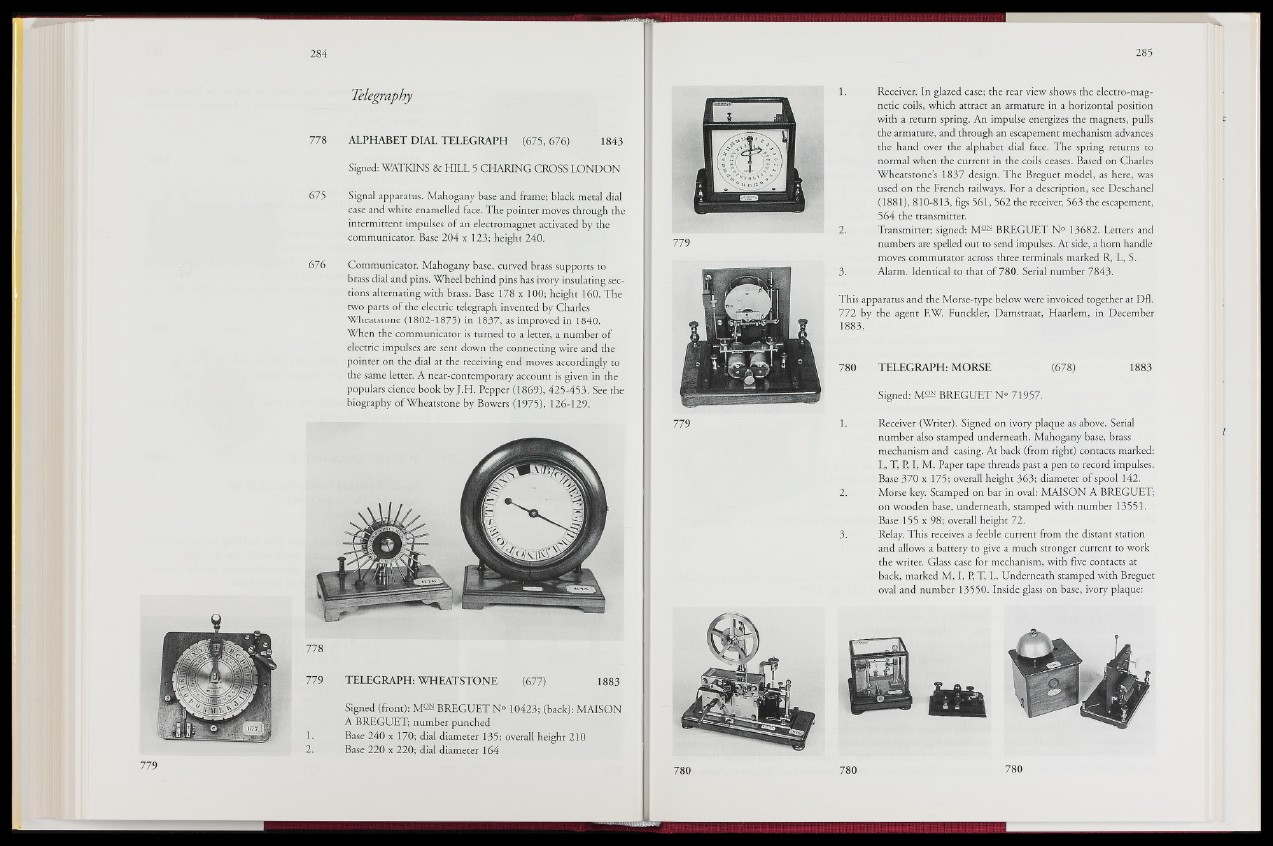
Telegraphy
778 ALPHABET DIAL TELEGRAPH (675,676) 1843
Signed: WATKINS & HILL 5 CHARING CROSS LONDON
675 Signal apparatus. Mahogany base and frame; black metal dial
case and white enamelled face. The pointer moves through the
intermittent impulses of an electromagnet activated by the
communicator. Base 204 x 123; height 240.
676 Communicator. Mahogany base, curved brass supports to
brass dial and pins. Wheel behind pins has ivory insulating sections
alternating with brass. Base 178 x 100; height 160. The
two parts of the electric telegraph invented by Charles
Wheatstone (1802-1875) in 1837, as improved in 1840.
When the communicator is turned to a letter, a number of
electric impulses are sent down the connecting wire and the
pointer on the dial at the receiving end moves accordingly to
the same letter. A near-contemporary account is given in the
populars cience book by J.H. Pepper | J 869), 425-453. See the
biography of Wheatstone by Bowers (1975), 126-129.
778
779 TELEGRAPH: WHEATSTONE (677) 1883
Signed (front): M ^ BREGUET N° 10423; (back): MAISON
A BREGUET; number punched
1. Base 240 x 170; dial diameter 135; overall height 210
2. Base 220 x 220; dial diameter 164
Receiver. In glazed case; the rear view shows the electro-magnetic
coils, which attract an armature in a horizontal position
with a return spring. An impulse energizes the magnets, pulls
the armature, and through an escapement mechanism advances
the hand over the alphabet dial face. The spring returns to
normal when the current in the coils ceases. Based on Charles
Wheatstones 1837 design. The Breguet model, as here, was
used on the French railways. For a description, see Deschanel
(1881), 810-813, figs 561, 562 the receiver, 563 the escapement,
564 the transmitter.
Transmitter; signed: M— BREGUET N° 13682. Letters and
numbers are spelled out to send impulses. At side, a horn handle
moves commutator across three terminals marked R, L, S.
Alarm. Identical to that of 780. Serial number 7843.
This apparatus and the Morse-type below were invoiced together at Dfl.
772 by the agent EW. Funckler, Damstraat, Haarlem, in December
1883.
780 TELEGRAPH: MORSE (678) 1883
Signed: M ^ BREGUET N° 71957; ;' *
Receiver (Writer). Signed on ivory plaque as above. Serial
number also stamped underneath. Mahogany base, brass
mechanism and casing. At back (from right) contacts marked:
L, T, P, I, M. Paper tape threads past a pen to record impulses.
Base 370 x 175; overall height 363; diameter of spool 142.
Morse key. Stamped on bar in oval: MAISON A BREGUET;
on wooden base, underneath, stamped with number 13551.
Base 155 x 98; overall height 72.
Relay. This receives a feeble current from the distant station
and allows a battery to give a much stronger current to work
the writer. Glass case for mechanism, with five contacts at
back, marked M, I, P, T, L. Underneath stamped with Breguet
oval and number 13550. Inside glass on base, ivory plaque: